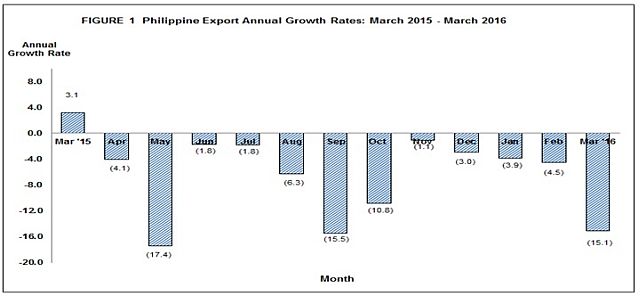
Philippine exports have declined for 12 consecutive months as the global economy continues to slow down. (psa.gov.ph)
Among 11 Asean economies, the Philippines saw the steepest decline in merchandise exports in March this year, according to the National Economic and Development Authority (Neda).
In a statement, the agency said the weak global economy has continued to pull down the country’s exports. Earnings have declined for 12 consecutive months since April 2015.
A report by the Philippine Statistics Authority (PSA) showed that total export earnings went down by 15.1 percent to $4.6 billion in March compared to $5.4 billion a year ago.
For the entire first quarter, export earnings were 8.4 percent lower this year at $13.1 billion compared to $14.3 billion in the same period last year.
Cebu exporters do not expect an improvement in the near term.
“Although we have our own internal problems, it’s our traditional international market that’s really down,” said Philexport Cebu chairman Allan Suarez Jr.
To survive, Suarez said most of the exporters turned to the local market.
“Some are okay and some are just surviving,” he said.
“The food sector is doing good, but not that big to make a dent. The sector is also affected by the El Niño. Production is so slow,” he added.
Socioeconomic Planning Secretary Emmanuel F. Esguerra, who is also Neda director-general, said Philippine exporters would have to tap non-traditional export destinations and products to widen their market base.
“It’s a necessary step in the midst of a challenging global economy. The country’s traditional trade partners continue to post subdued growth, global trade is not expected to pick up soon, and China’s slowdown is impinging upon overall growth in emerging economies,” Esguerra said in the statement.
He noted that Vietnam, China and Thailand posted positive export gains while the Philippines saw the steepest decline during the period. Lower revenues from several major trading partners also dragged exports in March 2016.
“To be able to reach out to other potential export markets and sell our products, it is crucial to ease government regulation and strengthen market intelligence gathering in partnership with the private sector. We also need to maximize the opportunities in trade agreements and economic groupings particularly within the Asean region,” Esguerra stated.
Esguerra said Philippine exports would have to increase by at least 8.3 percent in the next three quarters to attain the low-end projection of the Export Development Council of 5.4 percent in 2016.
In its report, the PSA said the decrease in March was attributed to the decline in seven major commodities out of the top 10 export commodities for the month.
These include apparel and clothing accessories (-52.2 percent), chemicals (-40.7 percent), metal components (-29.8 percent), machinery and transport equipment (-25.9 percent), electronic equipment and parts (-25.4 percent), other manufactures (-24.5 percent), ignition wiring set and other wiring sets used in vehicles, aircrafts and ships (-16.2 percent).
The gainers were woodcraft and furniture (up 28 percent), gold (25.9 percent) and electronic products (1 percent).

